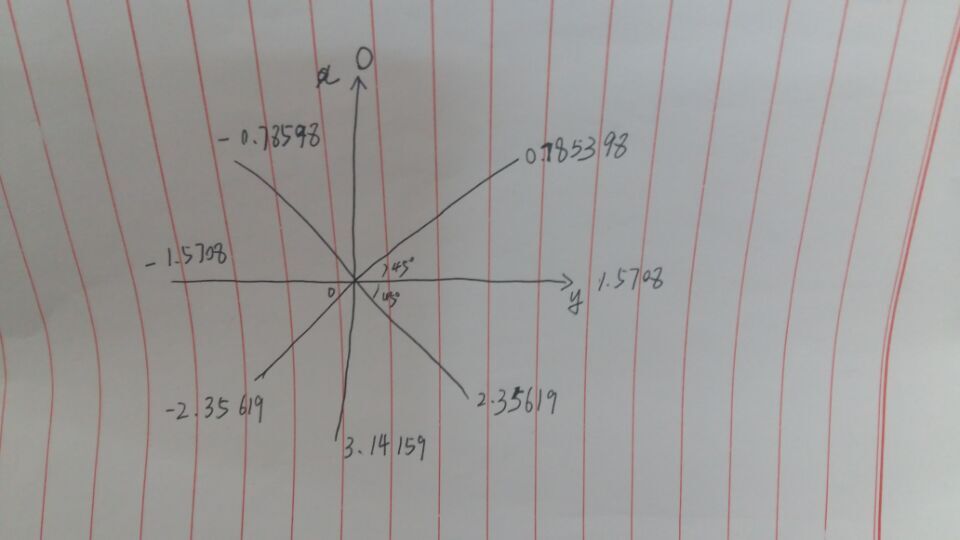输入一个点P和一条圆弧(圆周的一部分),你的任务是计算P到圆弧的最短距离。换句话说,你需要在圆弧上找一个点,到P点的距离最小。
提示:请尽量使用精确算法。相比之下,近似算法更难通过本题的数据。
Input
输入包含最多10000组数据。每组数据包含8个整数x1, y1, x2, y2, x3, y3, xp, yp。圆弧的起点是A(x1,y1),经过点B(x2,y2),结束位置是C(x3,y3)。点P的位置是 (xp,yp)。输入保证A, B, C各不相同且不会共线。上述所有点的坐标绝对值不超过20。
Output
对于每组数据,输出测试点编号和P到圆弧的距离,保留三位小数。你的输出和标准输出之间最多能有0.001的误差。
Sample Input
0 0 1 1 2 0 1 -1 3 4 0 5 -3 4 0 1
Sample Output
Case 1: 1.414 Case 2: 4.000
HINT
Source
上图即为atan2(x,y)反正切值在个个方向的大小变化
atan2(x1-x,y1-y)表示(x1,y1)以(x,y)为原点的反正切值
#include <iostream> #include <cstdio> #include <cstring> #include <cmath> #include <cstdlib> #include <algorithm> const double maxs=100000000; using namespace std; double x,y,r; /* double chaji(double ax,double ay,double bx,double by,double cx,double cy) //两条线段斜率的差,double !!! { return (by-ay)*(cx-ax)-(cy-ay)*(bx-ax); } */ void count(double x1,double y1,double x2,double y2,double x3,double y3) { double a,b,c,d,e,f; a=2*(x2-x1); b=2*(y2-y1); c=x2*x2+y2*y2-x1*x1-y1*y1; d=2*(x3-x2); e=2*(y3-y2); f=x3*x3+y3*y3-x2*x2-y2*y2; x=(b*f-e*c)/(b*d-e*a); y=(d*c-a*f)/(b*d-e*a); r=sqrt((x-x1)*(x-x1)+(y-y1)*(y-y1)); } double bj(double xp,double yp,double x1,double y1) { double s=sqrt((xp-x1)*(xp-x1)+(yp-y1)*(yp-y1)); return s; } double nodecount(double x1,double y1,double x2,double y2,double x3,double y3,double xp,double yp) { double f1=atan2(x1-x,y1-y); double f2=atan2(x2-x,y2-y); double f3=atan2(x3-x,y3-y); double f4=atan2(xp-x,yp-y);//atans(x,y)反切值函数,见c++函数应用,此时所求为(xp,yp)以(x,y)为原点的反切值 double ans1=fabs(r-bj(xp,yp,x,y));//fabs绝对值函数 double ans2=min(bj(xp,yp,x1,y1),bj(xp,yp,x3,y3)); //cout<<ans1<<" "<<ans2<<endl; if(f1<f3) { if((f2>=f1&&f2<=f3)==(f4>=f1&&f4<=f3)) return ans1; else return ans2; } else { if((f2>=f3&&f2<=f1)==(f4>=f3&&f4<=f1)) return ans1; else return ans2; } } int main() { int mark=0; double ans; double x1,y1,x2,y2,x3,y3,xp,yp; double k,k1,k2; while(~scanf("%lf%lf%lf%lf%lf%lf%lf%lf",&x1,&y1,&x2,&y2,&x3,&y3,&xp,&yp)) { mark++; count(x1,y1,x2,y2,x3,y3); // cout<<x<<y<<r<<endl; ans=nodecount(x1,y1,x2,y2,x3,y3,xp,yp); printf("Case %d: %.3lf ",mark,ans); } }
